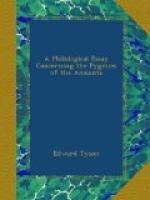Like the interior of some of the mound-dwellings already mentioned, these fairy caves are splendid habitations. “Their subterranean habitations are not less splendid and glittering than were their castles of yore on the mountain peaks. The one at Firtos is a palace resting on solid gold columns. The palace at Tartod and the gorgeous one of Dame Rapson are lighted by three diamond balls, as big as human heads, which hang from golden chains. The treasure which is heaped up in the latter place consists of immense gold bars, golden lions with carbuncle eyes, a golden hen with her brood, and golden casks, filled with gold coin. The treasures of Fairy Helen are kept in a cellar under Kovaszna Castle, the gates of the cellar being guarded by a magic cock. This bird only goes to sleep once in seven years, and anybody who could guess the right moment would be able to scrape no end of diamond crystals from the walls and bring them out with him. The fairies who guard the treasures of the Poganyvar (Pagan Castle) in Marosszek even nowadays come on moonlight nights to bathe in the lake below."[A] In Brittany, “a number of little men, not more than a foot high, dwell under the castle of Morlaix. They live in holes in the ground, whither they may often be seen going, and beating on basins. They possess great treasures, which they sometimes bring out; and if any one pass by at the time, allow him to take one handful, but no more. Should any one attempt to fill his pockets, the money vanishes, and he is instantly assailed by a shower of boxes on the ear from invisible hands."[B] In the Netherlands, the “Gypnissen,” “queer little women,” lived in a castle which had been reared in a single night.[C] The Ainu have tales of the Poiyaumbe, a name which means literally “little beings residing on the soil” (Mr. Batchelor says that “little” is probably meant to express endearment or admiration, but one may be allowed to doubt this). The Ainu, who is the hero of the story, “comes to a tall mountain with a beautiful house built on its summit. Descending, for his path had always been through the air, by the side of the house, and looking through the chinks of the door, he saw a little man and a little woman sitting beside the fireplace."[D]
[Footnote A: Folk Tales of the Magyars, p. xxxviii.]
[Footnote B: Grimm, apud Keightley, 441.]
[Footnote C: Testimony of Tradition, p. 86.]
[Footnote D: Folk Lore Journal, vi. 195.]
4. The little people or fairies occupy rude stone monuments or are connected with their building. In Brittany they are associated with several of the megalithic remains.[A] “At Carnac, near Quiberon,” says M. De Cambry, “in the department of Morbihan, on the sea-shore, is the Temple of Carnac, called in Breton ‘Ti Goriquet’ (House of the Gories), one of the most remarkable Celtic monuments extant. It is composed of more than four thousand large stones, standing erect in an arid plain, where neither tree




